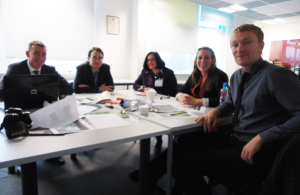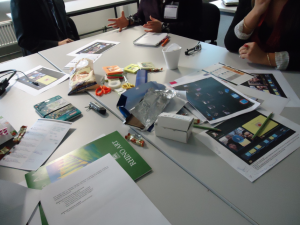Last week, two Focus Group sessions were performed at the Holmesdale Technology College in Kent, U.K., one with teachers and one with teachers and students. Holmesdale is an interesting school with a lot of opportunities for students to develop their design and technology skills. For example, the school offers one floor with facilities for engineering, textile projects and food design. Interestingly, the students are presented with a “learning-menu” of what they might learn by participating in activities within a particular room.
Teachers
The teachers that participated in the teacher focus group session along with me and an iTEC project partner from the Promethean Maindanhead offices in England taught subjects such as Maths, English as well as Design and Technology. During the 1,5 hour session we openly discussed the benefits and challenges of the prototypes TeamUp, ReFlex, Sessions and Learning Story Editor.
The conversations were energetic and focused mainly on using audio messages for reflection. For example, the teachers pointed out that instead of our guiding questions for reflection in TeamUp and Reflex, the teachers want to be able to enter their own questions, add instructions for students to guide them towards what kind of information they should specifically record. The teachers also wanted to see the amount of recordings a group made and which ones they had not viewed before. In ReFlex, students should decide what recordings to share and which they want to keep private. Hence, each recording on the timeline should have a separate sharing option.
Regarding collaborative classrooms, teachers thought that a serendipitously stumbling upon a connection, based on profile information would be more useful than actively searching of people to collaborate with. Particularly because there is no time to add sessions and search for sessions but the interest for collaborating with other classrooms is given.
Students
The session with students and teachers was equally rewarding. In total 4 students (2 girls, 2 boys) between 14 and 15 and two teachers participated in this session. The teachers had previously participated in the teacher session and were, hence, guided the conversation with probing questions a little bit. During the student-teacher session, we discussed and tried out the TeamUp tool, ideated benefits and drawbacks of ReFlex and lastly spoke about the Ambire rotating classroom idea.
The students appreciated that the rules and reasons for forming teams are transparent with the tool, as it sometimes appears random when teachers form team even if they form them with clear objectives in mind. Overall, the girls considered audio reflection messages more useful than rotating classroom. Especially because they could later go back on the notes they made in class and listen to them. Hearing voice and speaking about something would increase their memory of the “fact” opposed to writing it down. It is faster. For obvious reasons, the boys did not like their voices to be recorded, and thought that sharing their work via rotating classroom (Ambire) was better.










